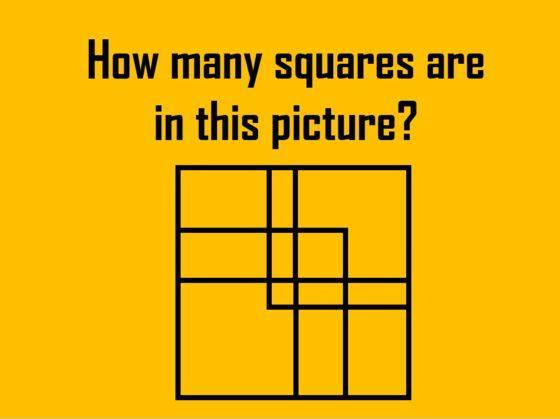Have you ever come across a question that seems too simple at first, but then makes you stop in your tracks? One such question that has puzzled many is, “How many squares are in this picture?” At first glance, the answer may seem obvious. However, upon deeper reflection, people often start second-guessing themselves. It’s not just about counting shapes—it’s about seeing the full picture. Let’s break it down and explore why this question is more complex than it appears.

The Common Answer: 8 Squares
When asked, “How many squares are in this picture?” most people confidently respond with the number 8. But why 8?
Typically, when presented with a simple grid of squares, people focus on the most visible ones: the large squares that are easily noticeable. This answer is often the go-to response because it feels straightforward. However, while 8 is correct in certain scenarios, this question has layers. Let’s dive deeper into understanding why people might struggle with such a seemingly simple problem.
The Visual Trick: Layers Within Layers
Here’s where things get interesting: the grid of squares can hide smaller squares within itself. At first glance, it might seem that there are only eight squares, but take a closer look. The visual structure of these grids often contains smaller squares nested within larger ones, making it easy to overlook some of them.
So, why does this happen? Our brains are wired to take shortcuts. When we see a larger pattern, we often ignore the smaller components, which can lead to miscalculations in puzzles like this. This visual trickery is a reminder that sometimes the simplest questions have more complex answers hiding in plain sight.
Breaking Down the Square Puzzle: Hidden Squares
To understand how the question could trick you, consider how squares are formed. In any grid or picture containing squares, the lines that create the shapes can intersect in multiple ways. This creates larger squares, smaller ones, and even overlapping squares. Let’s break it down step by step:
- The Big Picture: The Outer Square
The most obvious square is the large one that forms the border of the picture. This is the square that most people immediately notice. - Smaller Squares Within the Large Square
Once you identify the large square, take a closer look at its internal structure. You might discover smaller squares inside, formed by the intersecting lines or smaller grids. - Overlapping Squares
These are the trickiest to spot. Overlapping squares are often hidden by the larger shapes, but they’re still there if you look carefully. In fact, some squares are combinations of smaller ones, making the counting process more complex.
Why Our Brains Get Confused: Cognitive Bias at Play
So, why do so many people answer this question wrong, even after taking a second or third look? The answer lies in cognitive biases. Our brains tend to follow patterns, and we rely on them to make quick decisions. When faced with a visual puzzle like this one, we might rush to judgment based on the most prominent shapes we see, overlooking the details.
Additionally, this type of puzzle taps into our perception of spatial reasoning. Our eyes and minds are trained to look at the big picture, which means smaller details, such as hidden squares, can easily slip past us. This is why many people second-guess themselves when trying to solve this puzzle.
The Complexity of Simple Questions
Questions like “How many squares are in this picture?” serve as a reminder that not everything is as simple as it seems. They challenge us to slow down and look beyond the surface. Just like in life, the obvious answer isn’t always the correct one.

If you’ve ever faced a puzzle like this, you’ve likely experienced a moment of doubt after giving your answer. That’s normal. These puzzles are designed to make you question what you’re seeing and to challenge the way you process visual information. It’s almost like a mental workout, pushing your brain to think in new and creative ways.
Conclusion: The Power of Simple Questions
At first, a question like “How many squares are in this picture?” might seem like a no-brainer. However, as we’ve explored, even the simplest questions can reveal unexpected complexity when you dive deeper. This type of puzzle teaches us a valuable lesson: always look beyond the obvious, and don’t be afraid to question your assumptions.
The answer, in this case, might indeed be 8 squares, but the process of arriving at that number is what really matters. It’s not just about counting shapes—it’s about training your brain to see beyond the surface and appreciate the hidden intricacies that can often go unnoticed. So, next time you encounter a seemingly simple question, remember to slow down, observe, and think carefully—you might just surprise yourself with what you discover!





